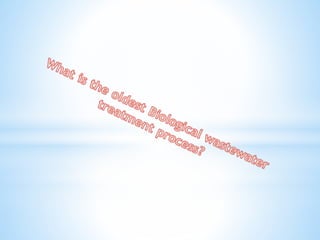
Integrated Fixed-Film Activated Sludge (IFFAS)
- 2. CIVI 6621 – Engineering aspects of Biological treatment of water and air Ibrahim Jammal - ID# 27683642 *
- 3. * • Introduction • Uses and Applications • Types of Media • Recent Studies and Developments • Conclusion
- 5. * • Industry practice for upgrading WWTP usually focuses on increasing the bioreactor volume by building new reactors to meet the system needs. What’s Integrated Fixed-Film Activated sludge (IFAS)? • IFAS is a modification of the conventional activated sludge process. • It is achieved by adding media to the aeration tanks of the Activated sludge process. • Creates a hybrid suspended- attached-growth system.
- 6. *IFAS using polypropylene textile media.
- 7. Why IFAS? •IFAS systems allow for the additional bacterial population to exist on a fixed surface, therefore no need to increase the suspended growth population. •Increased nutrient removal and better effluent quality. *
- 8. •The fixed biomass increases the Sludge Retention Time (SRT), promoting better nitrification. •Recent research indicates that autotrophic bacteria tend to grow more on fixed-film surfaces than in a suspended growth environment. •Resistant to Organic and Hydraulic Shock Loads. Applications: 1. Increase plant capacity while providing same treatment level. 2. Improve existing treatment performance in existing process at same plant capacity.
- 9. *
- 10. * • This study was conducted in the USA. • Study conducted on three full-scale plants : 1. A trickling filter/solids contact process, 2. A conventional plug flow activated sludge process, 3. An extended aeration process. The three plants were facing challenges before the IFAS upgrade. They were not able to meet the new ammonia limits due to either cold weather conditions or shock loadings.
- 11. • They either lacked the land needed for constructing new tanks, or it was not cost-effective to construct new tanks. • So PVC structured sheet media (SSM) was used as an IFAS.
- 12. * • SSM IFAS systems are a viable solution for retrofitting under-designed AS systems to increase ammonia removal (even under cold weather conditions) • potential to nitrify consistently with a high ammonia loading rate. • The IFAS system can significantly improve sludge settleability and reduce sludge production. It also improves BOD and TSS removal. • Operation and maintenance of a SSM IFAS system is very similar to that of an AS process and Attention to the media is minimal. This study just confirmed the efficiency of the IFAS, since IFAS was applied in full scales since 1980’s in Germany.
- 13. * • A similar problem was faced in China, they had AS WWTPs built before the development of industries in some areas. • A lab-scale IFAS system was employed to investigate the performance of pollutants removal in industrial effluent. Schematic of IFAS and the bio-carriers (polyurethane Plastic)
- 14. Results: • COD, NH4 +-N and TN removal efficiency of 74, 93 and 76%, respectively. • More nitrifying bacteria in the suspended-growth than in the attached-growth biomass. • Denitrifying bacteria were found enriched in the biofilms. • Aerobic denitrification was achieved in IFAS due to the accumulation of denitrifying bacteria in the bio-carriers. Better Processes could be used
- 15. * • The main aim of this study is to compare between IFAS-MBR and MBR systems. • Two lab-scale reactors were operated in parallel to treat synthetic municipal wastewater with continuous operation. • Polyethylene plastic bio-carriers were used in the Aerobic tank. Drawing showing the IFAS-MBR & MBR
- 16. Results: • This process result in a very compact process. • The carriers introduced to support the biomass duplicates the capacity of a conventional plant. • The IFAS–MBR showed a lower membrane fouling tendency during the whole operation. • IFAS–MBR showed a higher ability to remove COD. • Both systems had the same high removal efficiency of ammonium.
- 17. * • Nitrogen removal integrated with anaerobic ammonium oxidizing (anammox) process has been considered as a promising alternative to the conventional nitrogen removal processes (nitrification and denitrification). • It can be achieved under the conditions of low organic carbon sources and low aeration, reducing the operational cost and sludge production.
- 18. • Pilot and full-scale (IFAS) reactors were used. • Full Scale Reactor treating sludge dewatering liquors (V = 500 m³). • The pilot-scale was tested in treating high ammonium wastewater. • The biofilm carriers used in this study were cubic sponge polyesters. The Fig. shows (A) Scheme of pilot-scale IFAS reactor used in the experiment. (B) Scheme of full-scale IFAS reactor.
- 19. Results: • Nitritation–anammox process was successfully achieved in the IFAS system. • An average nitrogen removal efficiency of 85%. • Molecular analysis showed that ammonium oxidizing bacteria (AOB) were more abundant in in flocculent activated sludge while anammox bacteria were mostly located in the biofilm. • It was noted that high influent suspended solids would seriously affect the performance of the IFAS system. Therefore, a pre-treatment was proposed to reduce suspended solid.
- 20. * • Overall, IFAS proved to be a cost-effective method to retrofit existing AS plants, to either receive bigger flow, or improve the effluent quality. • Also it can be employed with other processes as the MBR or with Anamox to improve their performance. • In my opinion IFAS best application is treating municipal wastewater. Iince It didn’t show the ability to deliver high quality effluent in treating industrial wastewater. • At the end, I think all wastewater treatment methods are effective, But what makes the difference, is knowing when to apply these methods.
- 21. Thank You!